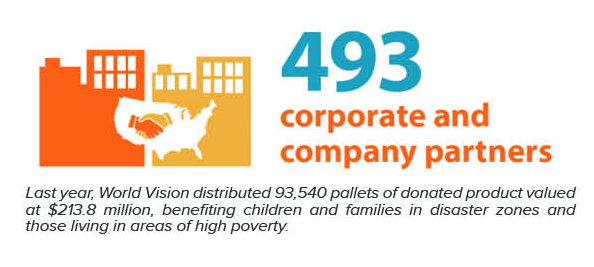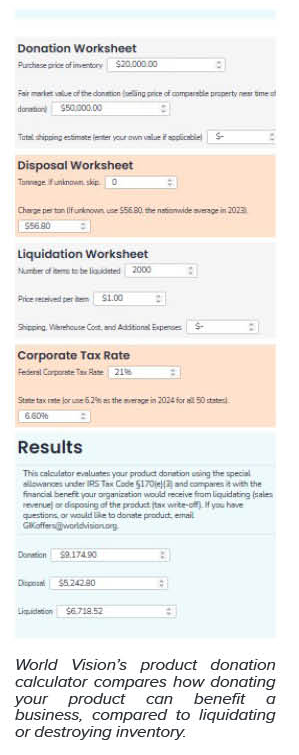Introduction
Companies across industries are rethinking how they handle excess and returned products—and for good reason. As operational efficiency, sustainability, and social impact become strategic imperatives, reverse logistics is evolving from a cost center into a powerful business driver. While recycling and refurbishing have long been part of the equation, product donation has often been overlooked as a practical solution that serves business goals and community needs. It’s a strategy that turns logistical challenges into social impact while offering tangible business benefits.
Reverse Logistics and Sustainability
The Council of Logistics Management (CLM) defines sustainability as “the role of logistics in recycling, waste disposal, and management of hazardous materials; a broader perspective includes all relating to logistics activities carried out in source reduction, recycling, substitution, reuse of materials and disposal.”1 While many businesses view reverse logistics as means to allay loss, proper implementation of reverse logistics can transform “products returns into profit centers.” Effective reverse logistics systems can lead to increased revenues, reduced costs, improved profitability, and enhanced customer service levels.

The Missing Piece in Many Reverse Logistics Operations
An often overlooked but highly effective component of reverse logistics is the donation of excess and returned goods to charitable organizations. Products that are unsellable—due to damaged packaging, open boxes, or minor flaws—can still be valuable to families in need. Donating these items provides a dual benefit: reducing waste and generating business advantages such as tax deductions, lowered storage and disposal costs, and enhanced brand reputation.
World Vision helps companies integrate product donation into their disposition strategy, ensuring excess inventory is responsibly distributed in disaster zones and among non-market participants in underserved communities—maximizing impact without compromising sales channels.3
Business Benefits of Product Donation
Operational Efficiency
Donating excess inventory can be a smart operations move. It helps companies clear space quickly, reduce carrying costs, and streamline supply chain management—especially during seasonal transitions, packaging changes, or when managing tariff-related surplus. Rather than spending time and resources liquidating or destroying unsellable goods, donation provides a strategic, impact-driven alternative.
Experienced nonprofit partners like World Vision make the process seamless. With the ability to receive donations ranging from a single pallet to over 300 truckloads per month—across more than 40 shipping locations—World Vision offers supply chain capabilities that rival for-profit logistics providers, while maximizing your impact.

Brand Reputation and Customer Loyalty
Engaging in philanthropic activities, such as donating products to those in need, enhances a company’s brand reputation. Consumers are increasingly favoring brands that demonstrate social responsibility, as evidence by a recent study that highlighted how sustainability initiatives improved customer relationships and competitiveness. By partnering with nonprofits like World Vision, companies not only support underserved communities, but also reinforce their commitment to social responsibility, thereby strengthening customer loyalty.

Financial Advantage
Donating excess inventory can be financially advantageous compared to other disposition options, including liquidation or disposal. The federal tax code allows for a tax deduction of up to twice the cost basis of donated product, which by itself typically lifts an organization’s bottom line more than even the revenue generated from liquidation sales. In addition, by allowing faster disposition decisions, donating product can also reduce costs associated with storage and disposal.
To support decision-making, World Vision offers an online donation calculator that helps businesses compare the financial impact of donating vs. liquidating or discarding inventory—often revealing that donation is the more profitable option.
Environmental Impact
Product donation also aligns with corporate sustainability by reducing waste and promoting the reuse of functional goods, extending product lifecycle. This practice minimizes the environmental footprint associated with manufacturing new products and disposing of unsellable inventory. Over the past five years, World Vision has helped keep nearly $1.2 billion worth of product out of landfills. For products with short life cycles, such as fresh produce or certain pharmaceuticals, an efficient returns process helps preserve more products, preventing them from being wasted or sold at reduced prices.
Donations given through World Vision exemplify how companies can implement sustainable practices that achieve their business goals, while benefiting both the environment and society.
Case Study: Logitech and World Vision
Logitech, a leading technology company, exemplifies the strategic benefits of donating excess and returned goods through its partnership with World Vision. In 2022, Logitech initiated a pilot program, donating 14,685 open-box products to World Vision’s Teacher Resource Centers (TRCs). These centers serve schools in areas of high urban and rural poverty across the United States. As a result of this collaboration, more than 4,000 students and teachers in Chicago and Phoenix received essential technological resources.5
“World Vision provides Logitech with ways of giving back in a meaningful and sustainable way. We extend the lifecycle of our open box products in a way that’s good for the environment. It’s a worthwhile investment in reducing our own carbon footprint and waste,” said Sacni Leon, Head of Global Inbound, Inventory Control, Reverse Logistics and Circularity Operations at Logitech.
Logitech’s commitment to sustainability and social responsibility is further demonstrated by its status as the first technology company to donate “open box” products to World Vision. These items, often returned or with damaged packaging, are fully functional but might otherwise be recycled before the end of their useful life. By donating these products, Logitech extends their lifecycle in a sustainable manner that benefits both the environment and underserved communities
Insights from Logitech and World Vision Representatives
Representatives from both Logitech and World Vision have emphasized the mutual benefits of their partnership.
“World Vision provides Logitech with ways of giving back in a meaningful and sustainable way. We extend the lifecycle of our open box products in a way that’s good for the environment. It’s a worthwhile investment in reducing our own carbon footprint and waste,” said Sacni Leon, Head of Global Inbound, Inventory Control, Reverse Logistics and Circularity Operations at Logitech.
“At World Vision, we see product donation not just as a charitable act, but as a smart supply chain strategy,” said Jack Laverty, National Director of Corporate Engagement at World Vision U.S. “We help our partners move excess inventory in a way that reduces waste, lowers costs, and delivers meaningful impact to families and communities across the country. It’s business with purpose—at scale.”

Conclusion
The practice of donating excess and returned goods through reverse logistics offers a sustainable solution that aligns evolving business needs with efficiency, sustainability, and social impact. As the partnership between Logitech and World Vision demonstrates, such collaborations can transform potential waste into valuable resources for underserved communities. By integrating product donation into reverse logistics, companies can enhance their brand reputation, achieve financial benefits, and contribute positively to society. This approach not only addresses the challenges of excess inventory but also exemplifies how businesses can operate responsibly in a global economy.
Corey Grant is a staff writer with World Vision. His passion is for crafting compelling stories that engage, delight, and inform. When not writing, you’ll find him chasing good coffee, hunting Pacific Northwest oysters, and searching for the next inspiring story.
Russ Shumaker is Sr. Leader, Partner Strategy & Experiences at World Vision. His focus is finding innovative solutions for corporate partners that also benefit disaster survivors and children and families in poverty.